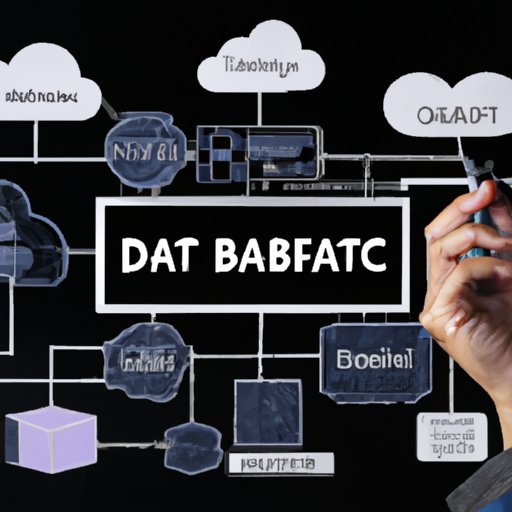I. Introduction
As the amount of data processed by modern businesses continues to grow, effective data management has become more critical than ever. Data fabric architecture is one of the latest technologies that has emerged to address the challenges of modern data management. This article provides a comprehensive overview of data fabric architecture, its benefits, applications, and future potential.
II. Understanding the Ins and Outs of Data Fabric Architecture: A Comprehensive Overview
Data fabric architecture is an innovative approach to data management that seeks to integrate diverse data sources to deliver consistent, high-quality data across the organization. It provides a unified framework for data access, management, and processing that encompasses all data types, formats, and storage systems regardless of their location, making them accessible to all authorized users.
Data fabric architecture evolved from the early days of data warehousing and has since seen significant growth in the adoption of cloud technologies and big data analytics. This has led to increased demand for modern data management solutions that can address the challenges of huge volumes of heterogeneous data stored in different locations.
Data fabric architecture addresses the challenges of data silos, fragmented data integration, and complex data infrastructure, which often lead to communication and visibility gaps between departments, delays in decision-making, inconsistencies, redundancies, and errors in data processing.
III. Why Data Fabric Architecture is a Game-Changer for Modern Business Operations
The benefits of data fabric architecture include improved data quality, increased agility and scalability, enhanced transparency, and compliance with regulatory requirements. It also enables businesses to leverage the power of machine learning and predictive analytics, improving their competitive edge.
Successful implementation of data fabric architecture has been recorded in various industries such as healthcare, finance, retail, and telecommunications. These companies have reported significant improvements in data processing speed, data accuracy, and operational efficiency. Some have also reduced their data infrastructure costs.
Data fabric architecture has a significant impact on business operations by enabling organizations to quickly adapt to changing customer needs, make informed decisions based on real-time data insights, and stay ahead of emerging trends.
IV. The Benefits and Potential Applications of Data Fabric Architecture in Today’s Data-Driven World
Data fabric architecture has numerous benefits in today’s data-driven world. These benefits include improved data accessibility and sharing, more efficient data processing and organization, and enhanced security and risk management.
Improved data accessibility and sharing enable authorized users to access the data they need from anywhere at any time, improving collaboration, decision-making, and productivity. More efficient data processing and organization lead to faster data retrieval, reducing the time needed to generate business insights. Enhanced security and risk management reduce data privacy and cyber threats, ensuring that critical data is secure and trusted.
V. Exploring the Top Tools and Techniques for Building Effective Data Fabric Architecture
Data fabric architecture requires an integrated approach to data storage, processing, and analysis, and there are several tools and techniques that can help organizations achieve this. Cloud-based solutions, such as Amazon Web Services (AWS) and Google Cloud Platform (GCP), offer flexible, scalable, and cost-effective storage and processing. Data integration tools like Informatica and Talend enable organizations to integrate data from diverse sources seamlessly. Machine learning and advanced analytics tools like Hadoop, Apache Spark, and R enable scalable, real-time data processing and analysis.
VI. Data Fabric Architecture Demystified: A Beginner’s Guide to This Revolutionary Technology
Data fabric architecture may seem intimidating to beginners, but it is a simple concept that requires only a few basic steps to implement. One should start by identifying data sources and the data sets needed. One should then establish data access and management policies that govern data sharing, processing, and storage. Finally, it is essential to ensure that the data is of high quality, integrated, and readily available to authorized users.
Best practices for data fabric architecture include starting small, focusing on high-priority use cases, and creating a solid data governance framework. Successful adoption and integration require training and knowledge transfer, stakeholder involvement, and ongoing optimization.
VII. Assessing the Role of Data Fabric Architecture in Emerging Trends like IoT and Big Data Analytics
The Internet of Things (IoT) and big data analytics are rapidly-changing trends that require modern data management architectures to leverage their full potential. Data fabric architecture provides a flexible and scalable foundation for IoT and big data analytics, enabling seamless integration and processing of sensor data, machine-generated data, and other data types. This helps organizations to make informed decisions, generate insights in real-time, and improve their competitive edge.
VIII. The Future of Data Management: How Data Fabric Architecture is Poised to Transform the Landscape
The future of data management is likely to see increased adoption of AI and machine learning, the use of cloud computing, and the integration of more data sources. As such, data fabric architecture is poised to transform the landscape of data management by providing a unified framework for processing and analysis of data with greater accuracy, efficiency, and scalability. Businesses may increasingly rely on data fabric architecture to make faster, more strategic decisions based on real-time data insights to boost their competitive advantage.
IX. Conclusion
Data fabric architecture is an innovative solution to the challenges of modern data management. It provides numerous benefits to businesses, including improved data accessibility, enhanced security, and risk management, and more efficient data processing and organization. Its potential applications are vast, and it has the potential to revolutionize the future of data management. Organizations that embrace data fabric architecture early stand to gain a significant competitive advantage and remain ahead of the curve. It’s time to act and make data fabric architecture a fundamental part of your organization data management strategy.
(Note: Is this article not meeting your expectations? Do you have knowledge or insights to share? Unlock new opportunities and expand your reach by joining our authors team. Click Registration to join us and share your expertise with our readers.)
